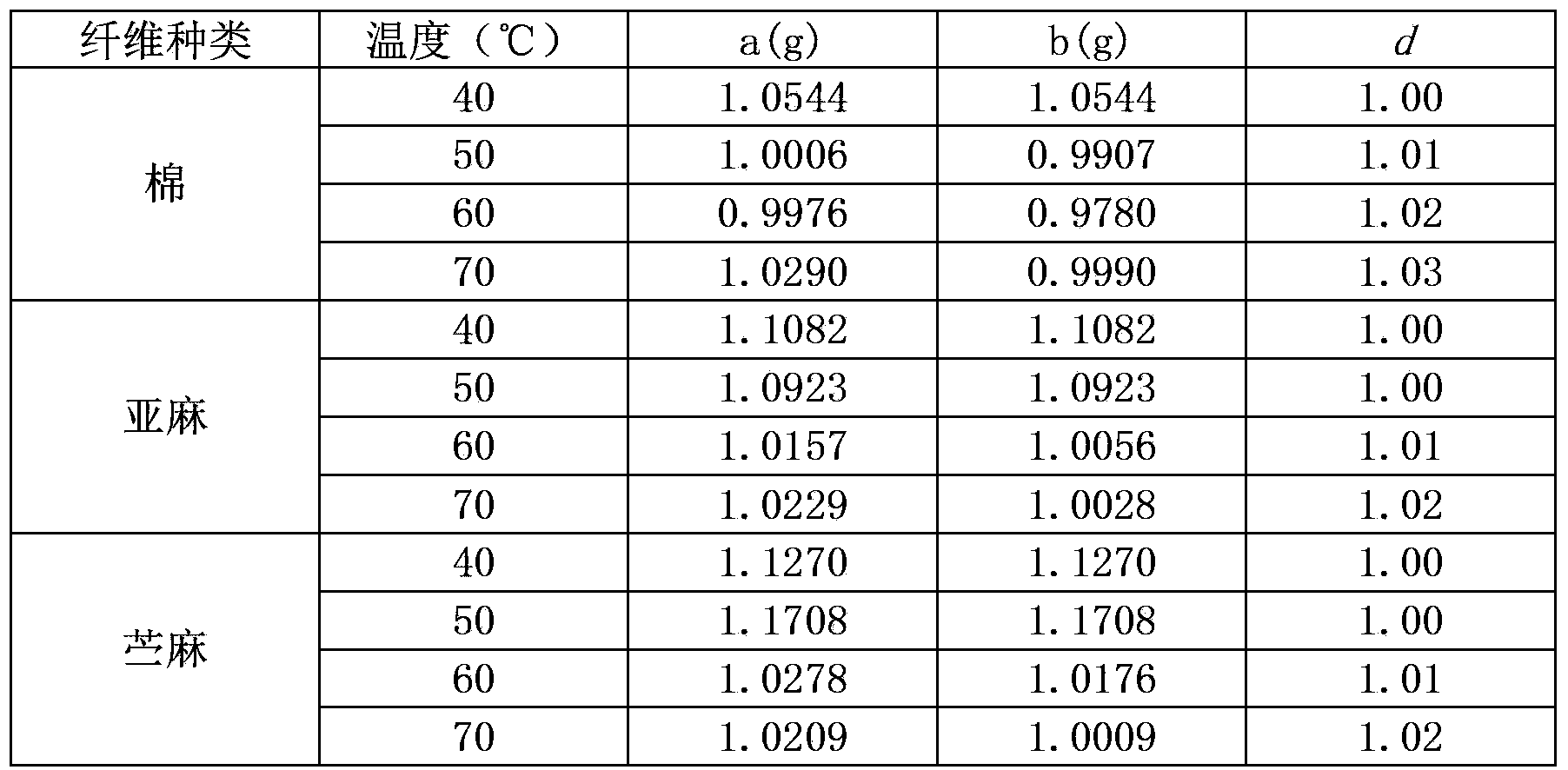Quantitative determination method for fiber content of viloft fiber and natural cellulose fiber blended textiles
A quantitative detection method, natural cellulose technology, applied in the direction of weighing by removing certain components, can solve the problems affecting the accuracy of measurement results, measurement work efficiency, low detection efficiency, etc., to improve detection efficiency and reduce detection time , The effect of reducing the melting temperature
- Summary
- Abstract
- Description
- Claims
- Application Information
AI Technical Summary
Problems solved by technology
Method used
Image
Examples
Embodiment 1
[0020] Embodiment 1 Natural cellulose correction factor test
[0021] Take a certain amount of natural cellulose fiber and place it in a constant temperature oven at 105°C for 3 hours. After fully drying, take it out quickly and place it in a desiccator to cool to room temperature. Weigh it with a balance with an accuracy of 0.1mg. The weight of natural cellulose fiber, denoted as a, according to the sample (g): reagent (mL) = 1:100 bath ratio, the natural cellulose fiber is placed in formic acid-zinc chloride solution (formic acid-zinc chloride solution is prepared by Add 20g of anhydrous zinc chloride and 68g of anhydrous formic acid to 100g), shake continuously at 40-70°C for 30 minutes, wash the natural cellulose fiber with water until neutral, and place it in a constant temperature oven at 105°C Dry it, then quickly take it out and place it in a desiccator to cool to room temperature, and weigh b with a balance with an accuracy of 0.1 mg. Comparing the size of a and b ju...
Embodiment 2
[0025] Embodiment 2 viloft fiber dissolving performance test
[0026] Take a certain quality of viloft fiber and place it in a constant temperature oven at 105°C for 3 hours. After it is fully dried, take it out quickly and place it in a desiccator to cool to room temperature. Use a balance with an accuracy of 0.1mg to weigh the weight of the fiber. Weight, according to sample (g): Reagent (mL) = 1:100 bath ratio Put viloft fiber in formic acid-zinc chloride solution (formic acid-zinc chloride solution consists of 20g anhydrous zinc chloride and 68g anhydrous formic acid plus water to 100g), after continuous shaking at 40-70°C for different times, observe the dissolution of viloft fibers. It can be seen from Table 2 that it takes 30 minutes for the viloft fiber to dissolve completely at 60°C; when the temperature is higher than 70°C, it only takes 20 minutes to dissolve completely.
[0027] Table 2 Viloft fiber dissolving performance test
[0028]
Embodiment 360
[0029] Dissolution test of cotton blended product at 360°C of embodiment
[0030] Take a certain amount of viloft fiber and cotton blended products whose component content is unknown, and place them in a constant temperature oven at 105°C for 3 hours. Weigh the weight of the blended product with a balance with a density of 0.1 mg, and record it as m 0 , according to sample (g): reagent (mL) = 1:100 bath ratio, put the blended product in formic acid-zinc chloride solution (formic acid-zinc chloride solution is composed of 20g anhydrous zinc chloride and 68g anhydrous formic acid plus water to 100g), viloft fibers were completely dissolved in formic acid-zinc chloride solution after continuous shaking at 60°C for 30 minutes, the insoluble fibers, namely cotton, were washed with water until neutral, and dried in a constant temperature oven at 105°C. Then quickly take it out and place it in a desiccator to cool to room temperature, and weigh m with a balance with an accuracy of 0...
PUM
 Login to View More
Login to View More Abstract
Description
Claims
Application Information
 Login to View More
Login to View More - R&D
- Intellectual Property
- Life Sciences
- Materials
- Tech Scout
- Unparalleled Data Quality
- Higher Quality Content
- 60% Fewer Hallucinations
Browse by: Latest US Patents, China's latest patents, Technical Efficacy Thesaurus, Application Domain, Technology Topic, Popular Technical Reports.
© 2025 PatSnap. All rights reserved.Legal|Privacy policy|Modern Slavery Act Transparency Statement|Sitemap|About US| Contact US: help@patsnap.com



